All you need to know about your products!

| 3DNews Vendor Reference English Resource - All you need to know about your products! |
||||||
 |
||||||
|
|
||||||
MSI P7NGM (NVIDIA GeForce 9300)Author:Date: 25/12/2008 Recently, NVIDIA has represented a new series of integrated GeForce 9ххх chipsets aimed at the Intel platform. Release of this family occurred a bit later than the similar series for the AMD platform, which is explained by greater complexity of development. The thing is, chipsets for Intel processors offer an integrated memory controller. However, late in 2008 it should be specified that we mean LGA775 processors since processors of the new Nehalem architecture (LGA1366) offer an integrated memory controller (therefore, it is missing in the chipset). Talking about the GeForce 9ххх series which includes GeForce 9300 and GeForce 9400 chipsets, we should point out a few important aspects. First, the chipset is of a single-chip make. Secondly, the chipsets are based on the G86 architecture, and the graphic core offers 16 shader processors. For comparison, the graphic core of NVIDIA GeForce 8200 (for the AMD platform) offers merely 8 similar processors. Thirdly, the only difference between GeForce 9300 and GeForce 9400 is in the clock speeds. In particular, the faster core of GeForce 9400 runs at 580 MHz, and the shader processors at 1.4 GHz. The core of GeForce 9300 is somehow slower: its frequency is 450 MHz, while the shader processors run at 1.2 GHz. 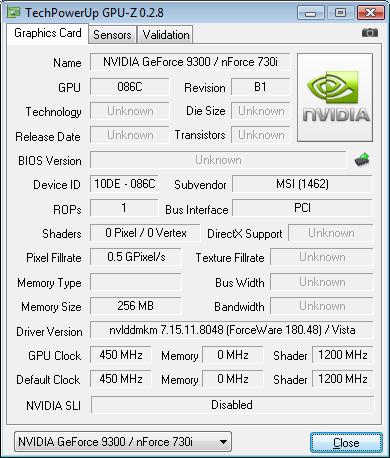 As it should be for the modern graphic core, chipsets of the GeForce 9ххх series support hardware decoding of video data in the H.264, VC1, and MPEG-2 formats. There is a dedicated NVIDIA PureVideo HD block responsible for that. Supported are also technologies like NVIDIA PhysX and CUDA. As regards the expansion options, we should first note support for the PCI Express v2.0 bus whose total number of lanes is 20. That means the option of installing one (or even two) PEG slots for external video cards on the motherboard. Therefore, NVIDIA has implemented the HybridSLI technology which allows consolidating the computational resources of the external video card and the integrated video core. Besides, the engineers still have four vacant PCI-E lanes which can be used at own discretion (in particular, to plug in Gigabit LAN controllers). 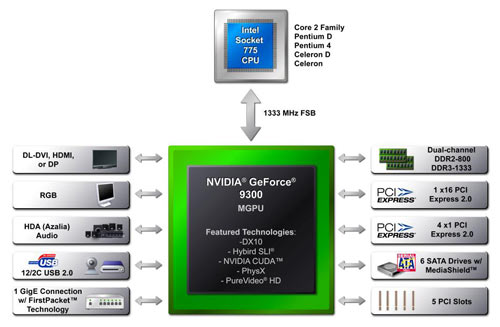 Besides the high-speed Ethernet, the new chipsets support six SerialATA II ports, 12 USB 2.0 ports, 7.1-channel LPCM HD Audio, as well as five PCI slots. The plugged in disks can be merged into a RAID array of levels 0, 1, 0+1, and 5. By the way, note that support for the ParallelATA is missing in the new chipsets. To implement it, the developers will have to install a separate controller. This is just the chip which is installed on MSI P7NGM which is the first representative of motherboards on the new series of NVIDIA chipsets that have been to our test lab. MSI P7NGM Specifications
Package Package bundle
The package bundle is quite scarce, but meets the level of a value product. For now, we can't tell anything else: we've got one of the first specimens of the board. In particular, there is not printed user's manual and you can't download the *.pdf version from the MSI's official web site because the description of the model is missing there. MSI P7NGM: Layout and FeaturesThe board's design has only one annoying trait - inconvenient positioning of the additional power connector.  Near the CPU socket, there is a 4-pin CPUFAN1 connector for a matching cooler.  Besides it, there is one 3-pin SYSFAN1 connector near the chipset. The connector does not have to be used because a mid-size radiator does quite a good job cooling the heat emission of the chipset:  Nearby, there is a couple of 240-pin DIMM slots for DDR2 memory modules, with the overall supported memory capacity being 4 GB. 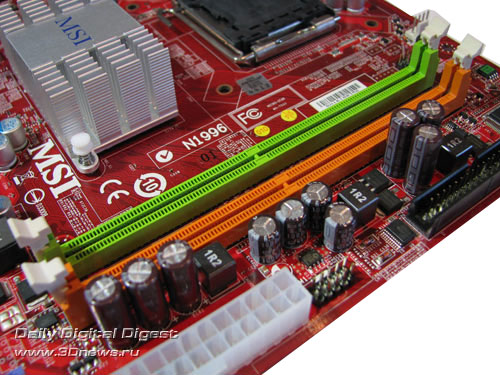 Expansion optionsThe board uses a PCI Express x16 slot which is meant for video cards.  Besides it, MSI P7NGM uses two more "regular" PCI slots, as well as a PCI Express x1 slot. Due to the GeForce 9300 chipset, the board supports six SerialATA II ports with support for RAID arrays of the levels 0, 1, 0+1, 5.  We should also note that the chipset does not support the ParallelATA interface, but to implement it the engineers had to install an additional JMB368 controller. Another trait of the board is in that the chipset supports 12 USB2.0 ports. However, only 8 are implemented on the board: 4 on the rear panel, with 4 more plugged in with brackets (missing in the bundle). The board supports one more type of the serial bus. These are two FireWire ports which are implemented due to the additional JMB 381 chip (one on the rear panel, the other - via a bracket). 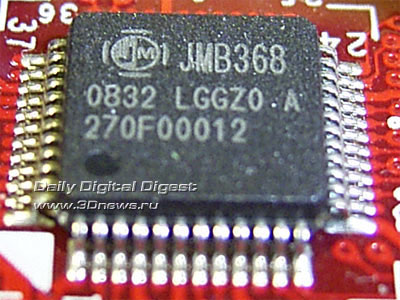 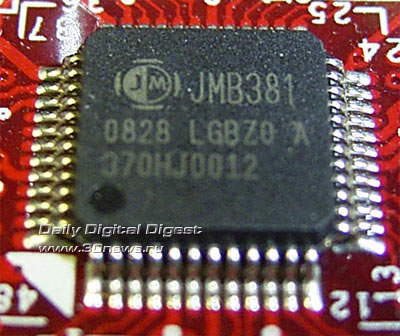 MSI P7NGM offers integrated 8-channel High Definition Audio, with the RealTek ALC888 chip used as the codec. Now a few words on the network support: the board uses a high-speed RTL 8111C (Gigabit Ethernet) LAN controller connected to the PCI Express (x1) bus.   The board's rear panel has the following configuration: 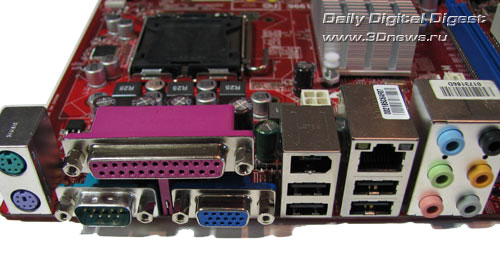 As compared to modern integrated boards, the rear panel of MSI P7NGM is archaic: there is neither DVI nor HDMI connector. On the other hand, the user gets a kit of outdated LPT and COM ports. By the way, the motherboard supports the second COM-port with a matching bracket. Now on to the BIOS settings. BIOSThe BIOS of MSI P7NGM is based on the AMI BIOS version, with its capacity being 4 Mbit.  The board allows the user to adjust the following memory settings: 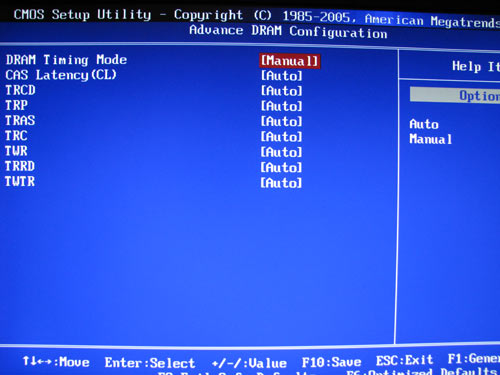 The selection of memory frequency is done both arbitrarily and depending on the FSB speed: 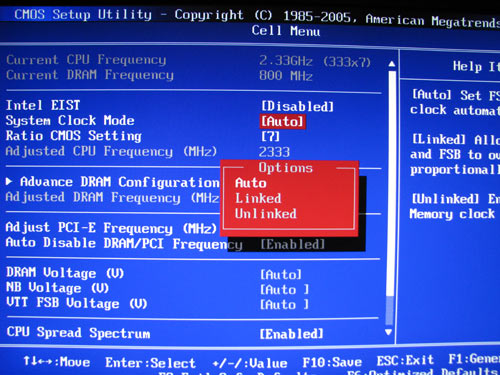 Also, the user can adjust the memory capacity allocated for the integrated graphics. 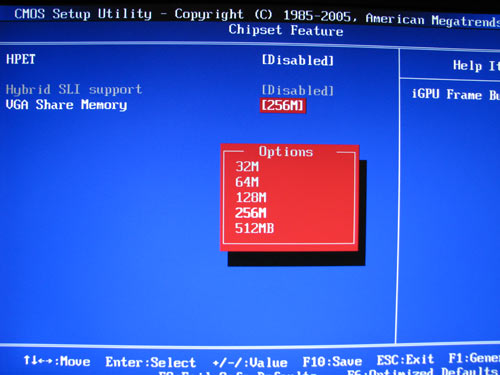 Now move on to the section to do with the system monitoring. 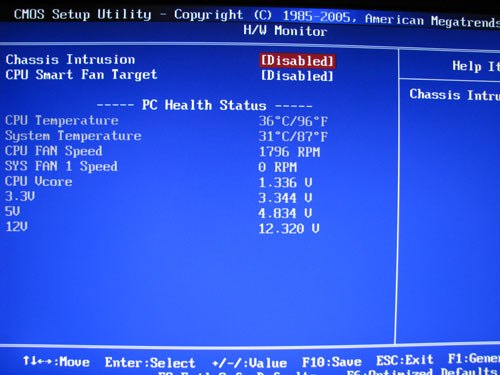 The board displays the current temperatures for the CPU and the system, rotational speeds of all the two fans, as well as the voltages. Besides, the CPU cooler is able adjusting the rotational speed depending on the CPU temperature using the SmartFan feature: 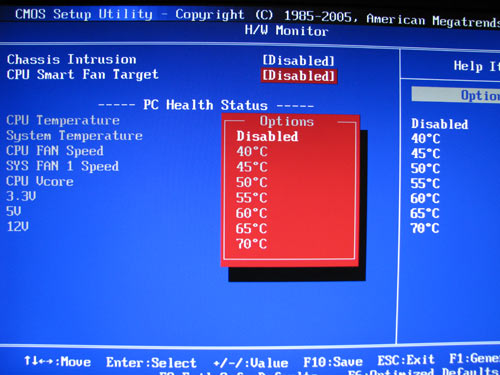 Overclocking and stabilityPrior to moving to overclocking, let's look into the power converter. It uses a 3-phase power scheme, in which there are four 1000 mkF and ten 680 mkF capacitors. 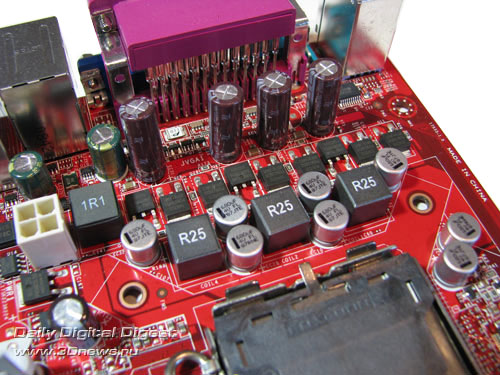 The overclocking tools are gathered in the "Cell Menu" section. 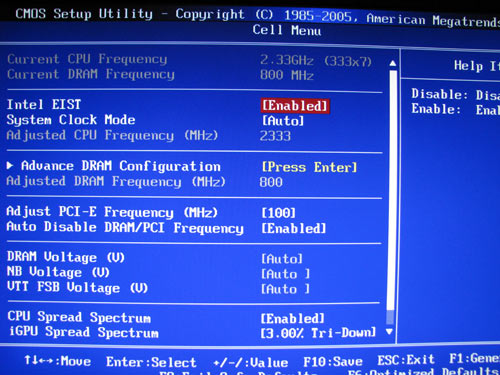 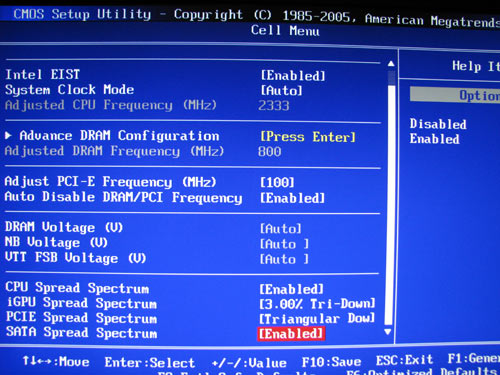 Overclocking tools:
The final result: stable FSB speed = 400 MHz.  Unfortunately, the overclocking capability of the board is quite low since the test specimen of the CPU runs without raising voltages at clock speeds about 2.8 GHz. So the lack of a feature for raising the Vcore did not affect the overclocking result. However, the board uses the starting BIOS version, and perhaps further versions of the firmware will improve the overclocking performance. Performance testsWhile determining the starting FSB speed, the board sets it at some overstatement. 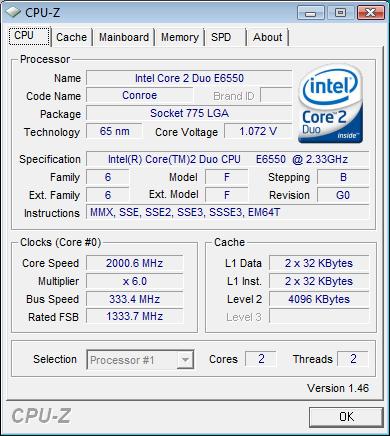 In our test setup, we used the following hardware:
We compared the performance of MSI P7NGM versus motherboards based on Intel chipsets (Foxconn G31MG-S based on G31, and Elitegroup G45T-M2 at G45). 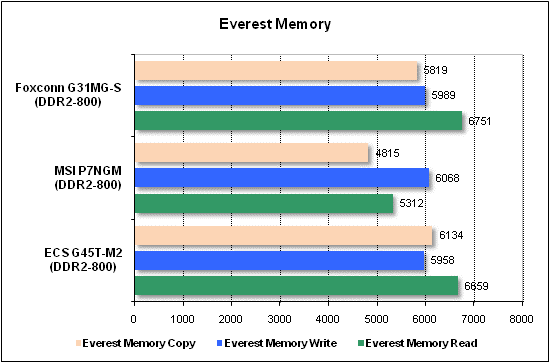 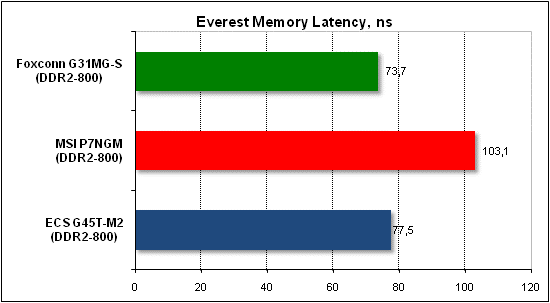 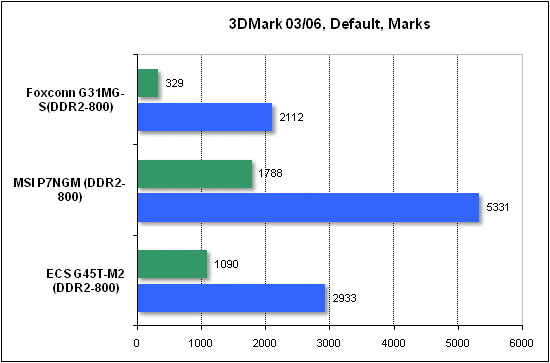 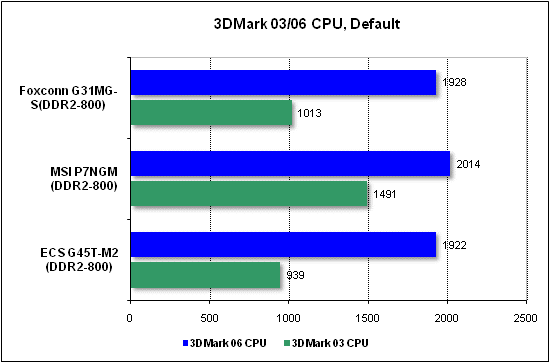 Now on to the gaming benchmarks. 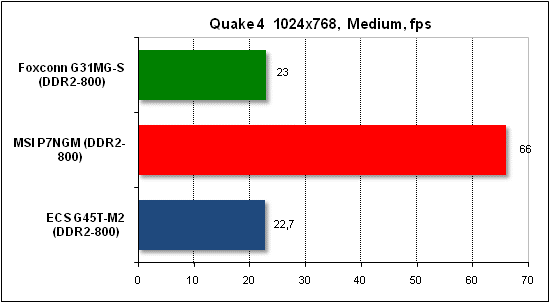 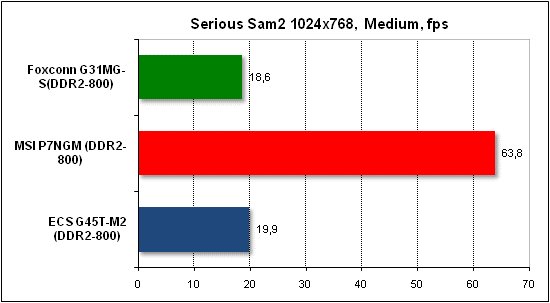 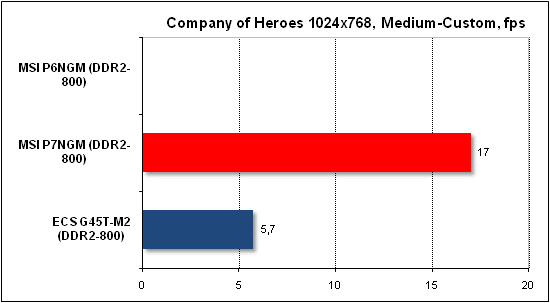 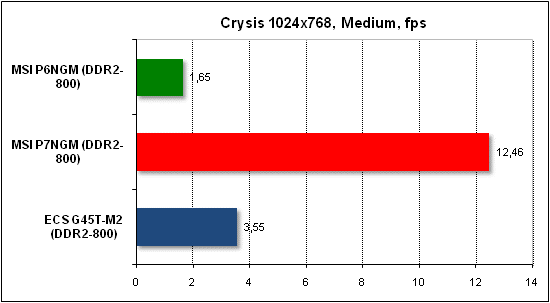 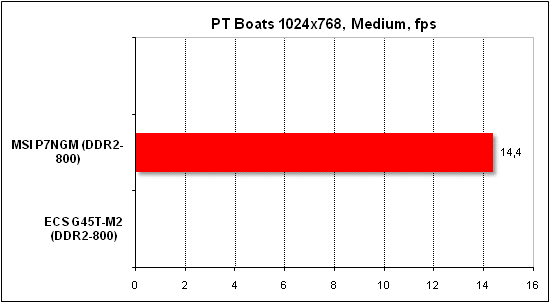 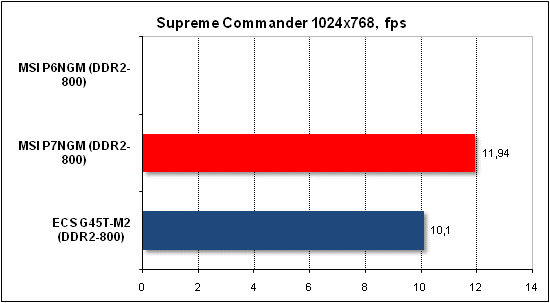 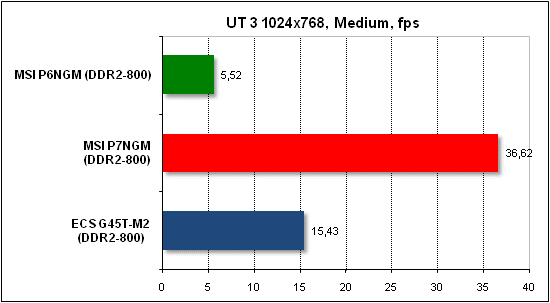 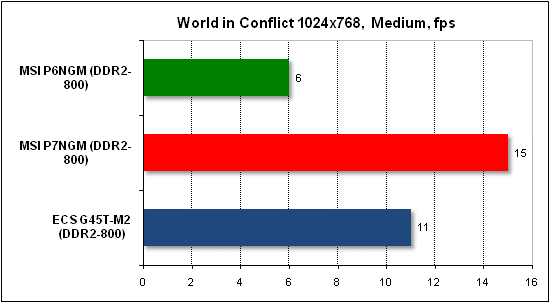 Tests of application software. 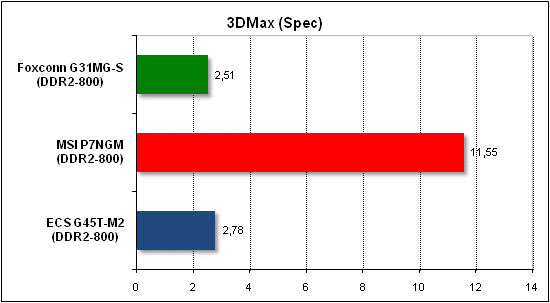 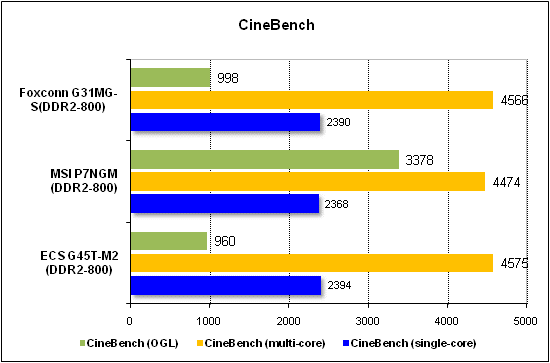 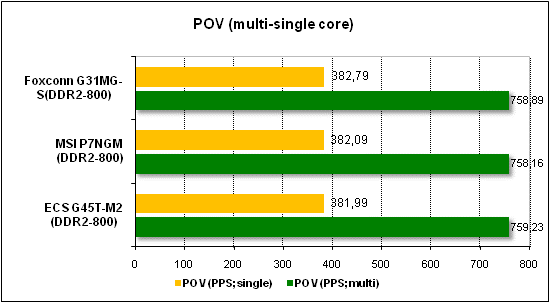
Video encoding (DivX, Xvid) was measured in seconds, i.e. the less the better.
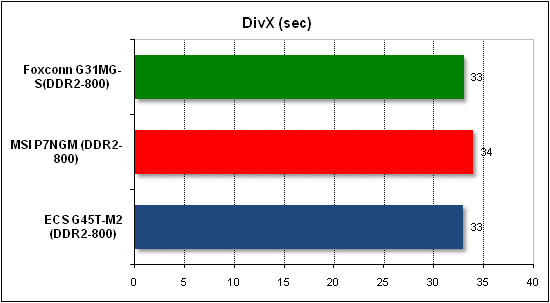 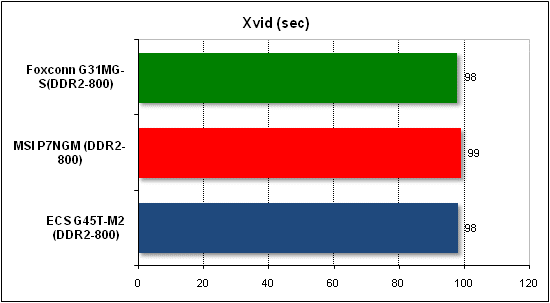
Data compression (WinRAR) was measured in Kb/sec, i.e. the more, the better.
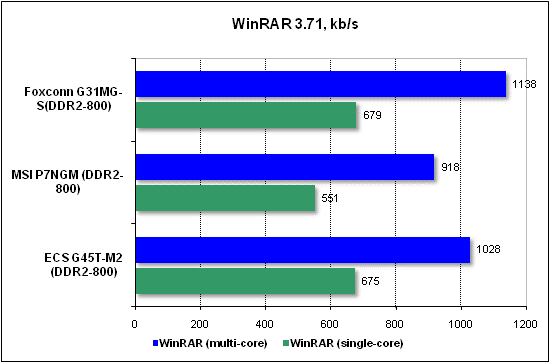 Final WordsFirst, conclusions regarding the NVIDIA GeForce 9300 chipset. In fact, this chipset is beyond competition at both the performance and the functional capabilities. In particular, at 3D applications NVIDIA's new product offers a twofold and even threefold advantage in speed. At its specifications, the integrated core of GeForce 9300 is quite similar to the core of GeForce 8300 aimed at the AMD platform. However, the GeForce 8xxx series has to compete against the quite powerful AMD 780G and 790GX chipsets, and the "arms race" on the AMD platform is at full sway. As regards the Intel platform, then having such a chipset like GeForce 9300 in the assortment NVIDIA can still be resting on its laurels for quite a long time. As regards MSI P7NGM, it is still difficult to make a comprehensive conclusion regarding it because there is still no info on the retail price. Moreover, there is no description of this model on MSI's official web site. On the other hand, we had no technical complaints regarding the board - its functional capabilities and the functionality are at quite a high level, and the board supports overclocking features. However, these features are quite middling at operation: we were able to attain merely a stable operation at FSB = 400 MHz. The only fault we found was about the configuration of the rear panel where there are outdated ports instead of carious video outputs. But that is not a serious shortcoming since in the assortment of MSI there is the MSI P7NGM-Digital version which offers a complete pack of video outputs (VGA, DVI, and HDMI). At the same time, this version has four DIMM slots but not two, as it is in the generic version P7NGM. ConclusionPros:
Cons:
The board's specific features:
- Discuss the material in the conference
|
||||||||||||||||||||||||||||||||||||||||||||||||||||||||||||
|
|||||